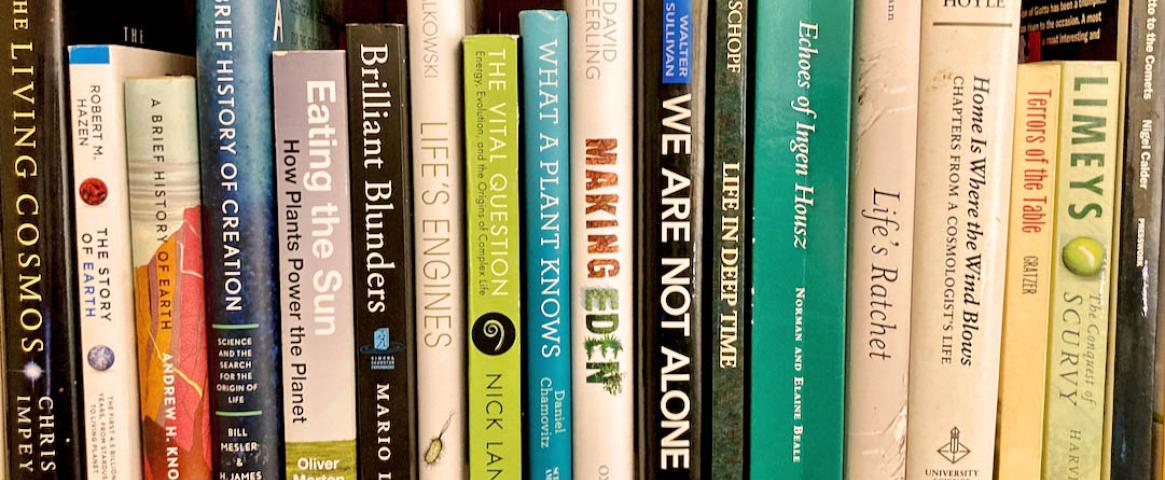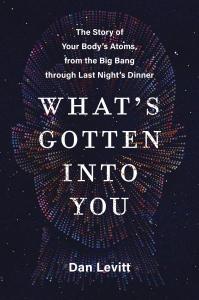
Dan Levitt—What's Gotten Into You: The Story of Your Body's Atoms, from the Big Bang Through Last Night's Dinner
THE STORY OF YOUR BODY'S ATOMS,
FROM THE BIG BANG THROUGH LAST NIGHT'S DINNER
Dan Levitt
HarperCollins, Jan 24, 2023, $25.60
ISBN-13: 978-0063251182, ASIN: B09YRR8DB6
Harper Audio (read by Mike Chamberlain)
ASIN: B09YVLK8TV
Levitt reports:
When my teenage daughter decided to become a vegetarian, I wondered what she would need to eat to stay healthy. I realized I had no idea what we are made of, much less where those molecules came from. I soon learned that every particle in our bodies emerged from the Big Bang at the beginning of time. Equally remarkably, we—collections of those particles—can now look back and retrace our 13.8-billion-year journey. I was hooked. I was a documentary filmmaker brainstorming ideas for films, but recognized that this was a great idea for a book.
My research soon turned up wonderful little-known stories: like how the priest Georges Lemaitre convinced Einstein of the Big Bang and how Cecilia Payne, “the best Man at Harvard,” showed what stars are made of. I learned how Martin Kamen’s and Sam Ruben’s discovery of carbon-14 helped crack photosynthesis and how the scientific maverick Peter Mitchell overturned our understanding of the way our cells create energy.
I aimed to reveal the heartbreak, rivalries, and erratic paths that led to many discoveries and recapture the wonder and awe they evoked—from the revelation that Earth was born from monstrous collisions to the many ways that photosynthesis is responsible for our existence. (Fun fact: 83 percent of your body’s mass was once floating in carbon dioxide molecules in the air.)To tell this sprawling story, I structured each chapter as a scientific detective story. How did researchers discover the smallest particles within us? How did they uncover our cells’ master blueprints?
I drafted an outline and then wrote a one-page summary for each chapter, which helped me refine the outline. After writing the first three chapters, I searched for agents, using Publisher’s Marketplace. Luckily, I emailed my second query to Suzanne Gluck, who phoned me that very same day and soon landed a publisher.
The writing took over four years, longer than I expected. The fact-checking alone took three months. I couldn’t have done it without feedback from beta readers. Next time I’ll use Zotero from the beginning for citations, bibliography, and tracking articles.
Contact info:
- Dan Levitt: 617-460-5720, Daniel.levitt@comcast.net, https://danlevitt.com/, @dan_levitt, https://www.linkedin.com/in/dan-levitt-a3a7085/
- Book: https://www.harpercollins.com/products/whats-gotten-into-you-dan-levitt, https://danlevitt.com/books/whats-gotten-into-you/
- Publicist: Tracy Locke, 212-207-7620, Tracy.Locke@harpercollins.com
- Agent: Suzanne Gluck, sg@wmeagency.com
NASW members: will your book be published soon? Take advantage of this opportunity for shameless self-promotion. Submit your report for Advance Copy.
Tell your fellow NASW members how you came up with the idea for your book, developed a proposal, found an agent and publisher, funded and conducted research, and put the book together. Include what you wish you had known before you began working on your book, or had done differently.
See https://www.nasw.org/advance-copy-submission-guidelines.
Review Advance Copy archives at https://www.nasw.org/member-article/advance-copy.
Thinking of writing a book? If you are a NASW member, you may access a list of more than 150 books and online resources to help you create your book proposal, find an agent and funding sources, negotiate your contract, learn about self-publishing, publicize and market your book, and more at https://www.nasw.org/article/write-book.
Watch for announcements of NASW Books Committee Advance Copy virtual events on the NASW events calendar. Coming up: Meet the Editors Looking for Op-Eds, Tuesday, April 4, 2023, noon, PDT. Event Access Link: https://www.nasw.org/virtual-events-auditorium. Member login required. View recordings of past events in NASW’s Video Archives.
Send book info and questions about book publishing to Lynne Lamberg, NASW book editor, llamberg@nasw.org.
Follow @LynneLamberg on Twitter for news about science/medical books and writing.
Banner image adapted from original photo by Dan Levitt. NASW members: share photos of your office bookshelves for use on other pages of the NASW website. Upload photos to bit.ly/naswpicsubmit
Advance Copy
The path from idea to book may take myriad routes. The Advance Copy column, started in 2000 by NASW volunteer book editor Lynne Lamberg, features NASW authors telling the stories behind their books. Authors are asked to report how they got their idea, honed it into a proposal, found an agent and a publisher, funded and conducted their research, and organized their writing process. They also are asked to share what they wish they’d known when they started or would do differently next time, and what advice they can offer aspiring authors. Lamberg edits the authors’ answers to produce the Advance Copy reports.
NASW members: Will your book be published soon? Visit www.nasw.org/advance-copy-submission-guidelines for information on submitting your report.
Publication of NASW author reports in Advance Copy does not constitute NASW's endorsement of any publication or the ideas, values, or material contained within or espoused by authors or their books. We hope this column stimulates productive discussions on important topics now and in the future as both science and societies progress. We welcome your discussion in the comments section below.


